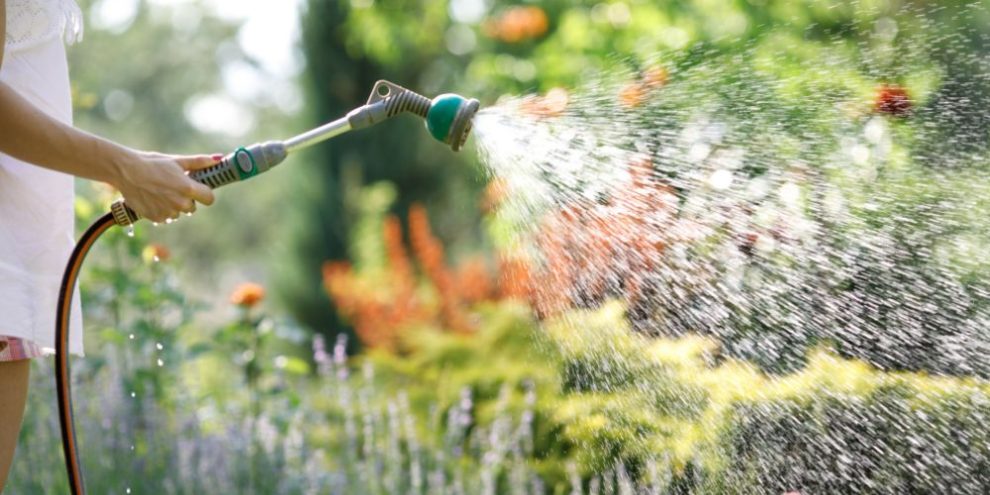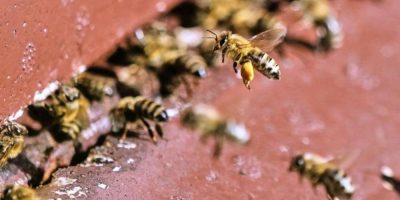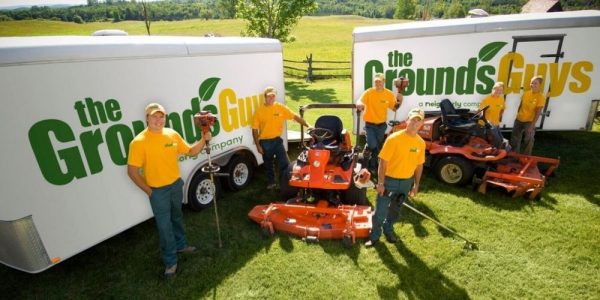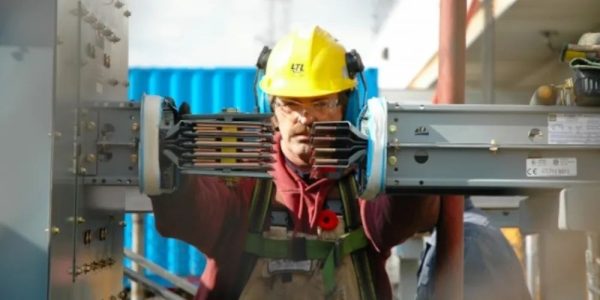
This Barrie 360 article is brought to you by United Lumber.
Lugging around a stiff, kinked hose while chasing after a runaway sprinkler is nobody's idea of a good time. But getting the watering done doesn't have to be a summer struggle. With the right garden hose and sprinkler combo, you can keep your lawn and plants looking their best without the frustration.
But with aisles overflowing with various lengths, diameters, materials, and purposes choosing the right hose and sprinklers can feel as daunting as untangling a nightmarishly knotted mess.
This guide will equip you with the knowledge to navigate the hose aisle with confidence, ensuring you choose the perfect tools to get the job done.
How to choose the best garden hose
There is a seemingly endless selection of garden hoses, which makes choosing the right one feel like a huge job. To help make the job easier, we are going to cover the many things you need to consider before heading to the garden aisle.
Different types of garden hoses
There are many different types of garden hoses. Some of the most popular ones include:
Standard Hose
This is the most common type of hose, typically used for general watering and cleaning tasks. They come in various lengths and are usually made of vinyl or rubber.
Soaker Hoses
These are porous hoses that allow water to seep out slowly along its entire length. They are ideal for watering plants as they deliver water directly to the roots, minimizing evaporation and water waste.
Sprinkler Hose
These hoses have tiny perforations down the length of the hose, sprinkling the surrounding area with water. Many sprinkler hoses can be flipped over to double at a soaker hose.
Flat Hose
These are hoses that can be laid flat on the ground and expand when filled with water. They are lightweight, easy to store, and perfect for tight spaces but they may not be as durable as standard hoses.
Coiled Hose
These hoses come in a pre-coiled design that helps prevent tangles and kinks. They are ideal for small areas or when you need a hose that is easy to maneuver. Coiled hoses are typically shorter than a standard garden hose.
Expandable Hose
These hoses are designed to expand several times their original length when filled with water and contract when emptied. They are lightweight, compact for storage, and easy to maneuver but may not be as durable as standard hoses.
Drinking Water Hose
These hoses are specifically designed for transporting drinking water. They are made from safe materials that won't leach chemicals into the water and are typically certified to meet national safety standards. Look for labels like "NSF-61" or "food-grade" to ensure they are suitable for drinking water. While it isn’t necessary, if you’re concerned about chemical leaching into your plants, you can use a drinking water hose for edible gardens.
RELATED: 7 tips for maintaining an outstanding year-round garden ...
Material matters
When choosing a hose, there are several characteristics your need to consider:
- Flexibility
- Ease of use
- Durability
- Longevity
Jeff Jackman, the general manager at United Lumber Home Hardware has been working in the home improvement industry for over 30 years. He explains, “As with most products, the type of material used to make a hose is directly related to both the performance and longevity of it. With that said, the type of material also directly relates to the price of a hose which is why there are various types to cover many different projects and customer expectations.”
Unfortunately, no hose gets a perfect score in all areas (though some get pretty close). For example, the more flexible your hose is, the easier it is to maneuver. But flexible hoses can also kink easily.
That’s why you need to decide what is most important to you and choose the hose that makes the most sense for your purpose.
Jeff talked to us about the common materials, along with their pros and cons.
Standard Vinyl
Vinyl is more lightweight making the hose easier to maneuver and less costly to produce, however they are not as flexible which leads to a higher chance of kinking. Vinyl hoses are also more prone to breaking down in extreme sunlight and under higher temperature scenarios.
Rubber
Rubber hoses are more durable and therefore less susceptible to kinking during use. They hold up much better under extreme sunlight and can handle both hot and cold water. Rubber hoses are easier to coil and uncoil so they tend to work better with hose reels but are typically more costly than vinyl ones.
Hybrids
Many manufacturers offer hoses that combine different materials. For example, vinyl and rubber are often combined to provide a balance between affordability, durability and ease of use. They can also have reinforced mesh exteriors for added protection against punctures.
Stainless Steel
Stainless steel hoses are still relatively new to the market but have proven to be a great option for certain applications. These hoses are extremely durable and can handle higher water pressure than both rubber and vinyl. They are virtually kink free so even when twisted or bent the water flow is not typically restricted. The downside to stainless steel hoses is they are typically more costly than both rubber and vinyl options.
Durability
As mentioned, material can affect durability. But you may notice that hoses sometimes have light, medium or heavy duty on them. Here's the best use for each type of garden hose:
Light Duty: Perfect for small gardens, potted plants, or occasional watering.
Medium Duty: Suitable for lawns, gardens, sprinklers, and moderate pressure washers.
Heavy Duty: Ideal for large properties, professional use, high-pressure applications, or areas with harsh weather.
Length is key
Most hoses come in lengths between 25 and 100 feet, though there are some shorter and longer options out there.
A 100-foot monster might seem ideal for reaching every corner of your property, but wrestling more hose than needed is no fun. The ideal hose length depends on the size of the area you need to reach with water.
You also want to consider your water pressure and storage.
Longer hoses may require more storage space and can reduce water pressure. If you need strong pressure for tasks like power washing, a shorter hose with a larger diameter (like 5/8 inches) might be better.
If you absolutely must conquer vast distances, you could also consider connecting two shorter hoses with a sturdy coupler.
Choosing the right hose length
Here's how to figure out what size hose you'll need:
- Measure the farthest distance: First, measure the distance from your water spigot to the farthest point you'll need to reach with the hose. This will give you a baseline length. When measuring this distance, Jeff recommends that you follow the pathways you will be walking to ensure the hose can reach without cutting across gardens and other delicate areas.
- Add some extra slack: It's generally recommended to get a hose that's a bit longer than the measured distance. This extra slack will give you more maneuverability and prevent you from pulling on the hose too much.
Diameter is more important than you think
Diameter may not seem like an important issue but it has a huge impact on water flow.
Jeff explains, “A larger diameter hose is able to produce more water volume but it typically does so with reduced water pressure. Therefore it’s important to recognize how the hose will be predominantly used when selecting the diameter.”
He continues, “If the garden hose will be mostly used for filling buckets, ponds, pools etc, then a larger diameter will typically be best. If the need is for the hose to carry a stronger water jet or will be hooked up to a sprinkler, hose nozzle etc. then a smaller diameter may be preferred in order to maintain higher water pressure.”
Here's a breakdown of the most common sizes:
½ inch (1.3 cm): This is appropriate for small lawns and gardens. It's lightweight, easy to maneuver, and delivers sufficient flow for basic watering tasks. However, pressure loss can occur over longer distances.
⅝ inch (1.6 cm): This diameter offers a balance between maneuverability and increased water flow. It is the most common diameter and is ideal for medium-sized lawns and gardens, or when using pressure washers or sprinklers.
¾ inch (1.9 cm): This is the heavyweight champion, providing the highest flow rate. It’s perfect for large properties, fast filling tasks, or situations with low water pressure. However, ¾ inch hoses are also heavier and bulkier to handle. It is generally used by professionals.
Added features
If that wasn’t enough to consider before buying a hose, there are several features to look out for. Each of these can help enhance the hose’s functionality and your overall experience.
- Kink Resistance: Look for hoses with ribbed exteriors, swiveling couplings, or internal kink-prevention coils. These features minimize frustrating kinks that interrupt water flow.
- Crush Resistance: For areas with heavy foot traffic or where the hose might get pinched, consider a hose with a reinforced outer layer to prevent accidental crushing.
- Comfort Grip: Watering shouldn't feel like a hand workout. Choose a hose with a ribbed or contoured grip for comfortable handling, especially for extended watering sessions.
- Leak-proof Couplings: Leaky connections are a pain. Look for hoses with brass or heavy-duty plastic couplings that ensure a secure and watertight fit.
Hose fittings and accessories
The effectiveness of your garden hose also relies heavily on the fittings and accessories you use with it.
These often small yet crucial components can make the difference between a smooth watering experience and a frustrating battle with leaks and mismatched connections.
So, let's delve into the world of garden hose attachments and explore what they do and when you need them:
Fittings
Hose fittings are essentially the connectors that attach hoses to other hoses, equipment, or water sources. They come in various shapes and sizes depending on the application and hose type.
When choosing fittings, look for octagon shaped ones made of metal. They cost a bit more money but they’re easier to use and will last longer. For a more affordable option, select brass fittings. They are corrosion resistant, and widely available but are not recommended for hard water. Stainless steel is more expensive but also more durable. They are also more corrosion resistant and can be used for hard water.
Here's a breakdown of the most common fittings and their key functions:
- Threaded Connectors: These are the classic screw-on fittings that come standard on most hoses. They provide a secure connection, ideal for permanent attachments or when water pressure is a concern. They can also be used for more permanent connection of multiple hoses.
- Quick-Connects: These handy connectors allow for easy attachment and detachment of hoses with a simple push and twist. They’re perfect for situations where you frequently switch between watering tools or need to move the hose around a lot.
- Repair Couplers: A leaky hose doesn't mean a trip to the store. Repair couplers help mend a damaged section by connecting two hose ends, effectively bypassing the leak.
- Hose Splitters: Need to water multiple areas simultaneously? A hose splitter, typically with two or four outlets, allows you to connect several watering tools or hoses to a single faucet.
- Shut-Off Valves: These valves are lifesavers when you need to adjust water flow out of the faucet or choose which areas to water when using splitters.
- Timers: For forgetful gardeners (or those with busy schedules), hose timers automate watering schedules. Simply attach the timer to your faucet, connect the hose, and program the watering duration and frequency.
Garden Hose Nozzles
Nozzles are the handy attachments you connect to the end of your garden hose to control the water flow and spray pattern.
Here are the most common nozzles and what they are used for:
- Adjustable Nozzle: Adjustable nozzles offer a variety of settings, typically including mist, shower, jet, and flat spray. This versatility makes it suitable for most general watering tasks, from drenching thirsty shrubs to gently misting delicate seedlings.
- Pistol Grip Nozzle: This ergonomic design features a comfortable trigger for easy control of water flow. Pistol grip nozzles are ideal for targeted watering or tasks requiring frequent adjustments, like cleaning your patio or car.
- Watering Wand: For those hard-to-reach areas or raised garden beds, a watering wand is a game-changer. These extendable nozzles put the water flow directly in your hand, allowing for precise targeting without contorting yourself. Many watering wands also offer adjustable spray patterns for added control.
- Fan Nozzle: As the name suggests, this nozzle creates a flat, fan-shaped spray. Ideal for watering large areas like lawns or flower beds, the fan nozzle ensures even water distribution and reduces the risk of runoff.
- Spot Spray Nozzle: For pinpoint watering or weed control, a spot spray nozzle is your secret weapon. This focused stream allows for precise application of water or herbicides, minimizing waste and protecting surrounding plants.
- Fire Nozzle: Need a powerful blast of water for cleaning gutters or dislodging stubborn dirt? A fire nozzle delivers a high-pressure stream, perfect for tough jobs around the yard.
Popular Accessories
There are many other popular accessories that can be used with your hoses. These include:
- Hose Splitters: These enable you to connect multiple hoses or watering tools to a single water source, allowing you to water different areas of your garden simultaneously or use additional attachments without disconnecting the hose
- Shut-Off Valves: These valves are lifesavers when you need to adjust water flow out of the faucet or choose which areas to water when using splitters.
- Repair Kits: These are good to have on hand for quickly repairing leaks, punctures, or damaged hose ends. They typically include hose menders, clamps, and washers, allowing you to extend the lifespan of your garden hose.
Reels and Hangers
When it comes to maintaining and extending the longevity of your hoses, reels and hangers are key. Depending on your space and desired aesthetic, you have a few different options:
- Cart Hose Reel: The cart hose reel is a mobile unit with wheels. You can unwind the hose as you go, then easily maneuver it around your yard. Carts typically offer a larger hose capacity and some even feature storage compartments for watering tools. Ideal for large yards or frequent movement between watering zones.
- Swivel Hose Reel: This wall-mounted garden hose reel offers the best of both worlds – space-saving convenience and easy unwinding. Swivel reels pivot, allowing you to extend the hose in any direction without detaching it. Perfect for medium-sized yards where a cart might be cumbersome and a stationary reel limits reach.
- Wall-Mounted Hose Reel: A classic space-saver, the wall-mounted hose reel keeps your hose neatly coiled and off the ground. Simply crank the handle to unwind and rewind the hose. These reels come in various sizes and materials, with some offering automatic rewind features for added convenience. Ideal for smaller yards or patios where a cart might be too bulky.
- Decorative Wall-Mounted Hose Hanger: For a touch of style alongside functionality, decorative wall-mounted hose hangers offer a charming solution. These come in various designs, often crafted from weather-resistant materials like cast iron or wrought iron. While not ideal for long hoses, they add a touch of personality and keep shorter hoses neatly organized.
How to choose the right sprinkler
Now that your hose is ready for action, let's explore the wonderful world of sprinklers!
Before diving into sprinkler types, it's crucial to understand your lawn's specific requirements. Here are key factors to consider:
- Size and Shape: Measure your lawn's length, width, and any odd-shaped areas. This helps determine the sprinkler's throw distance and coverage pattern.
- Sun Exposure: Full-sun areas dry out faster than shady spots. Consider sprinklers with adjustable watering times for targeted watering.
- Soil Type: Sandy soil drains quickly, requiring more frequent watering. Clay soil retains water better, so sprinklers with lower flow rates may be suitable.
- Water Pressure: Water pressure at your hose bib determines the performance of some sprinklers. Check your pressure with a gauge to ensure compatibility.
Types of sprinklers
Like hoses, there are many different types of sprinklers, each with their own purpose. Here are some of the most common sprinklers and what they are commonly used for:
Stationary/Fixed Spray Sprinklers
These offer a fixed spray pattern, perfect for watering specific areas. They're budget-friendly and low-maintenance, but not ideal for oddly shaped yards.
Multi Stream Sprinkler
Unlike traditional fixed-spray heads that blast water in a single pattern, these clever heads emit thin, multi-directional streams. This reduces runoff and allows for even watering on medium lawns, delicate plants, slopes, and uneven ground.
Bubbler/Flood Sprinkler
These sprinklers are ideal for deep watering of trees, shrubs, and other plants with focused root systems. Unlike traditional sprinklers that spray water in a wide pattern, bubblers deliver a slow, gentle flow directly to the base of the plant.
Impact/Impulse Sprinklers
These classic sprinklers feature rotating arms that throw water in a pulsating motion. Ideal for large, open areas, they offer excellent coverage but can be wasteful on windy days. But remember, these bad boys can pack a punch, so they may not be suitable for delicate plants.
Oscillating Sprinklers
These back-and-forth sprinklers are perfect for rectangular lawns. They offer even coverage but may waste water on sidewalks or flowerbeds.
Rotary Sprinkler
These high-efficiency sprinklers rotate a single or multiple nozzles, providing even coverage for medium to large lawns. Effective in windy conditions due to their larger water droplets. Choose from various rotation patterns to optimize coverage for your lawn's shape.
Choosing the right sprinkler features
Once you've narrowed down the type of sprinkler, there are a few other factors you need to consider:
Water Efficiency: Look for sprinklers with certifications like WaterSense, indicating lower water consumption. Adjustable flow rates and timers further enhance efficiency.
Durability: Sprinklers made of UV-resistant plastic or metal will last longer under constant sun exposure. Opt for brass or stainless steel components for enhanced durability.
Ease of Use: Features like easy-adjust spray patterns, step spikes for secure placement, and shut-off valves simplify operation and maintenance.
Smart Sprinklers: These high-tech options connect to Wi-Fi or smart home systems, allowing for remote control, scheduling, and weather-based adjustments for optimal watering.
Measuring your lawn for sprinklers
When choosing a sprinkler, you want to be sure it will cover the desired area. Most sprinkler packaging will tell you the square footage they cover. Measure your yard and/or garden area and find a sprinkler that will cover the greatest area possible. In most cases you will still need to move the sprinkler around to different areas of your outdoor space. Still, purchasing the hose and sprinkler that best aligns with your yard size will reduce the need to do this.
Maintaining Your Hoses and Sprinklers
With a little TLC, your hose and sprinklers will keep your yard flourishing for years to come.
Jeff explained, “Direct sunlight deteriorates a hose over time. Keeping your hose out of the sun with a hose reel, or at least keeping it under a roof overhang, is extremely important.
“Breakdown of the threads is another problem that can happen over time and leads to a hose leaking and becoming less effective. Using quick connectors is another great way to extend the life of both your hose and sprinkler as you’re able to easily move from one accessory to another without actually screwing and unscrewing each time.”
After each use, drain any excess water from the hose to prevent bacteria growth and potential damage from freezing temperatures. Store your hose loosely coiled and out of direct sunlight to avoid cracks and warping.
For sprinklers and nozzles, regularly inspect heads for clogs or leaks, and clean them gently with a soft brush.
When winter comes, bring your hose, sprinklers and hose nozzles inside. Jeff shared, “This is probably the most important thing you can do to ensure a long life for your garden hose and accessories. Water left in a hose, sprinkler or nozzle, in the winter will freeze and expand. This expansion will often cause it to leak from the connection joints. Bringing these items inside to a heated area over the colder months will allow it to dry out completely and will improve itss long term performance.”
By following these steps, you can ensure your watering system functions efficiently for years to come.
Watering doesn't have to be a chore
By choosing the right hose and sprinkler combo, you can transform watering from a tedious task into a breeze.
So ditch the drudgery and embrace the ease and satisfaction that comes with having the perfect watering setup.
RELATED: Everything you need to know about raised garden bed ...












